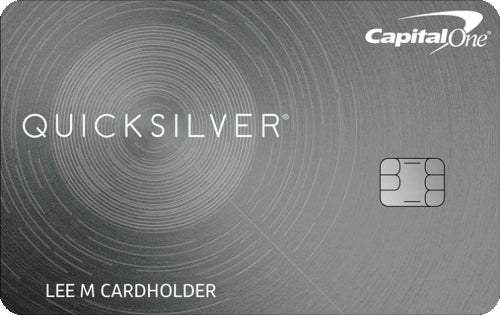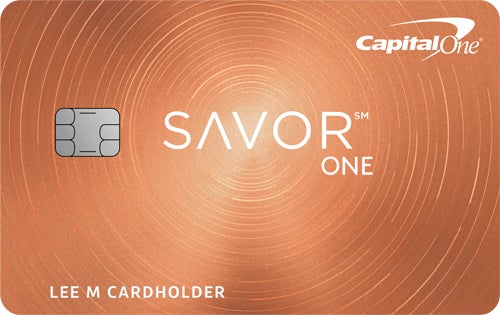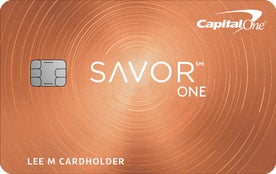Summary
The Capital OneSavorOne and Quicksilver come free of annual fees, and their complementary earning structures ensure you’ll earn more rewards over time – possibly over $700 in your first year.
The content on this page is accurate as of the posting date; however, some of our partner offers may have expired. Please review our list of best credit cards, or use our CardMatch™ tool to find cards matched to your needs.
A standard cash back credit card with flat-rate rewards can help you earn hundreds of dollars in cash back each year, and it’s certainly better than nothing. Yet, some consumers opt to sign up for more than one card so they can double up on sign-up bonuses and take advantage of credit card bonus categories.
One cash back duo that works rather well is the Capital One SavorOne Cash Rewards Credit Card and Capital One Quicksilver Cash Rewards Credit Card. Both cards come free of annual fees, and their complementary earning structures ensure you’ll earn more rewards over time – possibly up to $700 or more in your first year.
If you’re wondering whether you would be better off with two Capital One cards instead of one, you’re certainly not alone. Read on to see why pairing the Capital One SavorOne and Quicksilver cards could be a smart idea.
Comparing the SavorOne and Quicksilver
Both the SavorOne card and Quicksilver are issued by Capital One and offer competitive cash back, but they have distinct differences when it comes to their earning rates.
 Capital One Quicksilver Cash Rewards Credit Card |  Capital One SavorOne Cash Rewards Credit Card |
Rewards rate
| Rewards rate
|
| Sign-up bonus $200 if you spend $500 in first 3 months | Sign-up bonus $200 if you spend $500 in first 3 months |
| Annual fee $0 | Annual fee $0 |
At first glance, you might think that the SavorOne is better suited for cardholders who spend heavily on dining, entertainment and groceries, while the Quicksilver is more suited to those whose budgets don’t lean heavily in any direction. But, in fact, carrying both cards can be the most lucrative move of all. Here’s why.
Maximize bonus categories
The Capital One SavorOne card offers useful bonus categories almost anyone can benefit from, including 3% cash back on dining, entertainment, select streaming services and grocery stores. These categories don’t have any limits, meaning you can earn as much cash back as you want every year.
If you sign up for the SavorOne card and spend $200 at grocery stores and $400 on dining and entertainment every month, you can earn $216 in cash back in a year. You’ll also earn the $200 welcome offer after spending $500 on purchases in the first three months, bringing the year one rewards haul on this card to $416. And you aren’t limited to that amount – the sky’s the limit on how much cash back you can earn.
One downside of the SavorOne card is that it only gives you 1% back on regular spending. But that’s where the Capital One Quicksilver card comes in. This card makes it easier to maximize your rewards since it gives you 1.5% back on all regular purchases.
If you spend $600 per month on the Quicksilver card, you can earn $9 per month or $108 in cash back your first year. Throw in the $200 statement credit you earn after spending $500 on purchases within the first three months, and you’ll rack up $308 in cash back during the first 12 months of membership.
With these two cards combined, you could easily earn well over $300 in cash back your first year – even without taking sign-up bonuses into account. Here’s how those rewards might look over the first 12 months of owning both cards:
| Cash back strategy | ||
|---|---|---|
 SavorOne card Earn $416 in the first year | + |  Quicksilver card Earn $308 in the first year |
| Total cash back earned = $700 | ||
Here’s how:
| ||
If you add in each of the sign-up bonuses, you’re at $724 in cash back earnings your first year. And that’s just the beginning of what you can earn.
Redeem for flexible rewards
Both of these cash back credit cards let you cash in your rewards for statement credits at a rate of 1 cent apiece. You can’t go wrong with this option. After all, everyone can benefit from statement credits that can be used to pay for anything – even monthly bills.
If you’re in the mood to splurge on yourself, make sure to check out Capital One’s selection of gift cards, many of which go for 1 cent per point. You can also use Capital One rewards to shop for merchandise with your rewards, although you’ll typically get a lot less value if you do. As an added bonus, you can also use rewards from either card to make purchases on Amazon.com or through PayPal.
Finance a large purchase at 0%
Both the Quicksilver and SavorOne grant you 15 months with a 0% introductory APR on purchases, followed by a variable APR of 16.49% to 26.49%. This means you can buy something expensive – say, new appliances for your kitchen or a vacation to the Bahamas – and pay it off over 15 months without forking over a dime in interest.
Bottom line
Sometimes two rewards credit cards are better than one, and the fact that these two cards can help you earn $724 or more your first year proves it. The reality is, both the Capital One SavorOne and Capital One Quicksilver are worth having, and that’s especially true if you strategically use both for all your regular spending and bills.
Editorial Disclaimer
The editorial content on this page is based solely on the objective assessment of our writers and is not driven by advertising dollars. It has not been provided or commissioned by the credit card issuers. However, we may receive compensation when you click on links to products from our partners.






